Strategic Management of Woolworths Group
VerifiedAdded on 2023/06/14
|17
|3590
|373
AI Summary
This report conducts external and internal environment analysis of Woolworths Group, evaluates its issues and provides appropriate recommendations. It analyses the external environment of Woolworths Group by using PESTEL and Porter’s five force analysis. For internal environment analysis, VRIO model is used in the report. The report finds that the firm is facing issues due to high competition, lack of innovation, pricing strategy and others. In order to address these issues, the firm can improve its online services, improve its pricing strategy and collaborate with other retailing firms.
Contribute Materials
Your contribution can guide someone’s learning journey. Share your
documents today.
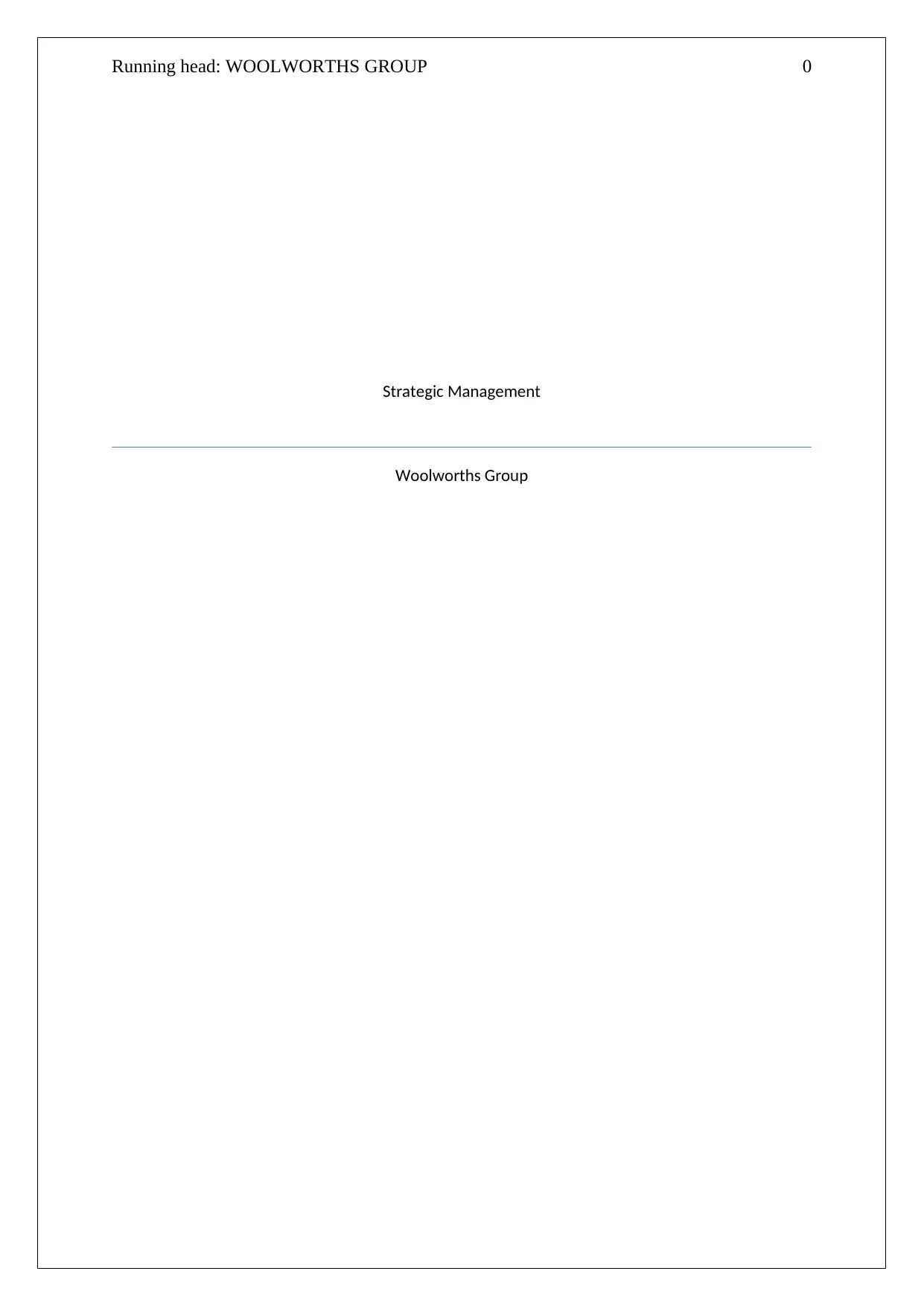
Running head: WOOLWORTHS GROUP 0
Strategic Management
Woolworths Group
Strategic Management
Woolworths Group
Secure Best Marks with AI Grader
Need help grading? Try our AI Grader for instant feedback on your assignments.
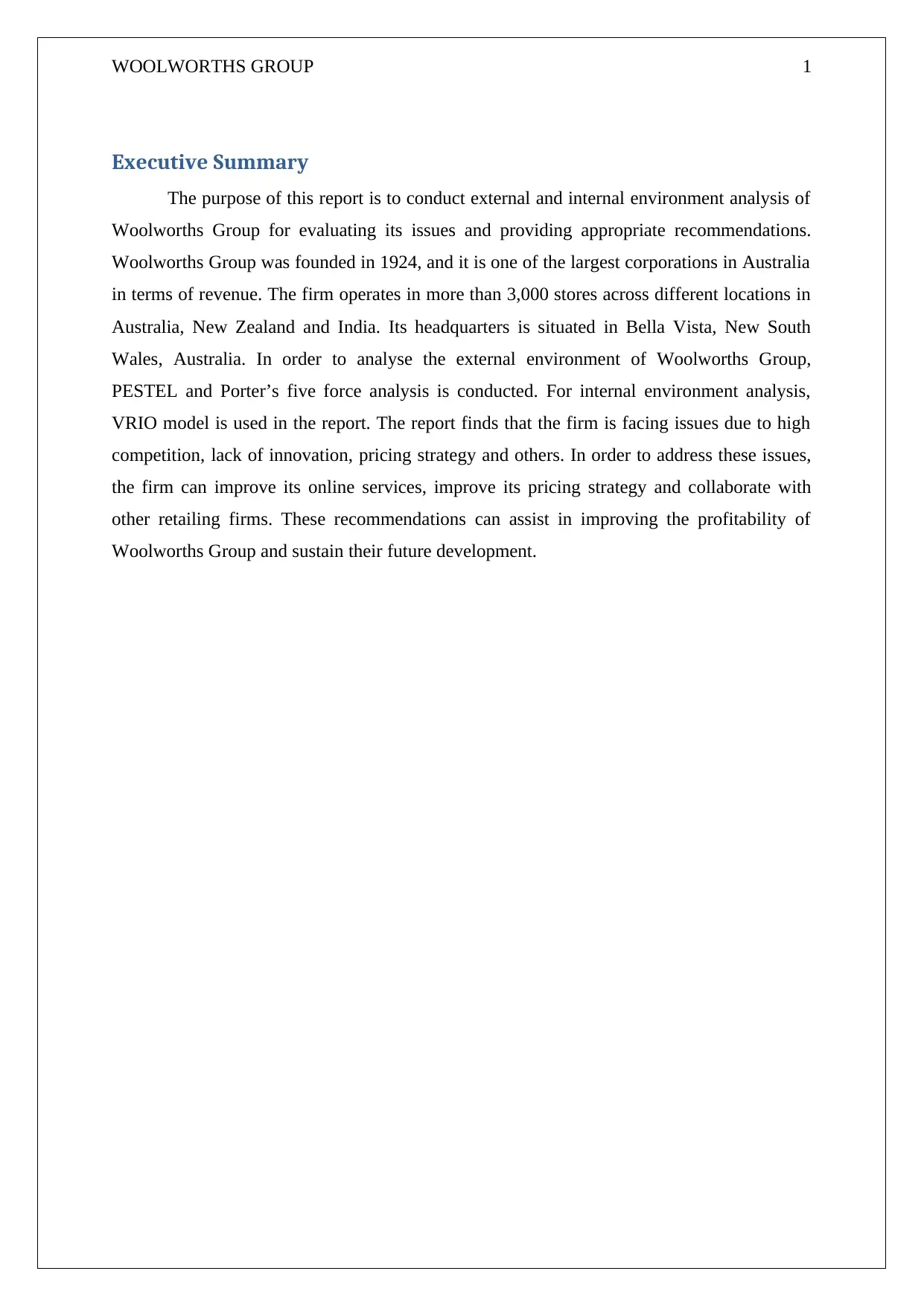
WOOLWORTHS GROUP 1
Executive Summary
The purpose of this report is to conduct external and internal environment analysis of
Woolworths Group for evaluating its issues and providing appropriate recommendations.
Woolworths Group was founded in 1924, and it is one of the largest corporations in Australia
in terms of revenue. The firm operates in more than 3,000 stores across different locations in
Australia, New Zealand and India. Its headquarters is situated in Bella Vista, New South
Wales, Australia. In order to analyse the external environment of Woolworths Group,
PESTEL and Porter’s five force analysis is conducted. For internal environment analysis,
VRIO model is used in the report. The report finds that the firm is facing issues due to high
competition, lack of innovation, pricing strategy and others. In order to address these issues,
the firm can improve its online services, improve its pricing strategy and collaborate with
other retailing firms. These recommendations can assist in improving the profitability of
Woolworths Group and sustain their future development.
Executive Summary
The purpose of this report is to conduct external and internal environment analysis of
Woolworths Group for evaluating its issues and providing appropriate recommendations.
Woolworths Group was founded in 1924, and it is one of the largest corporations in Australia
in terms of revenue. The firm operates in more than 3,000 stores across different locations in
Australia, New Zealand and India. Its headquarters is situated in Bella Vista, New South
Wales, Australia. In order to analyse the external environment of Woolworths Group,
PESTEL and Porter’s five force analysis is conducted. For internal environment analysis,
VRIO model is used in the report. The report finds that the firm is facing issues due to high
competition, lack of innovation, pricing strategy and others. In order to address these issues,
the firm can improve its online services, improve its pricing strategy and collaborate with
other retailing firms. These recommendations can assist in improving the profitability of
Woolworths Group and sustain their future development.
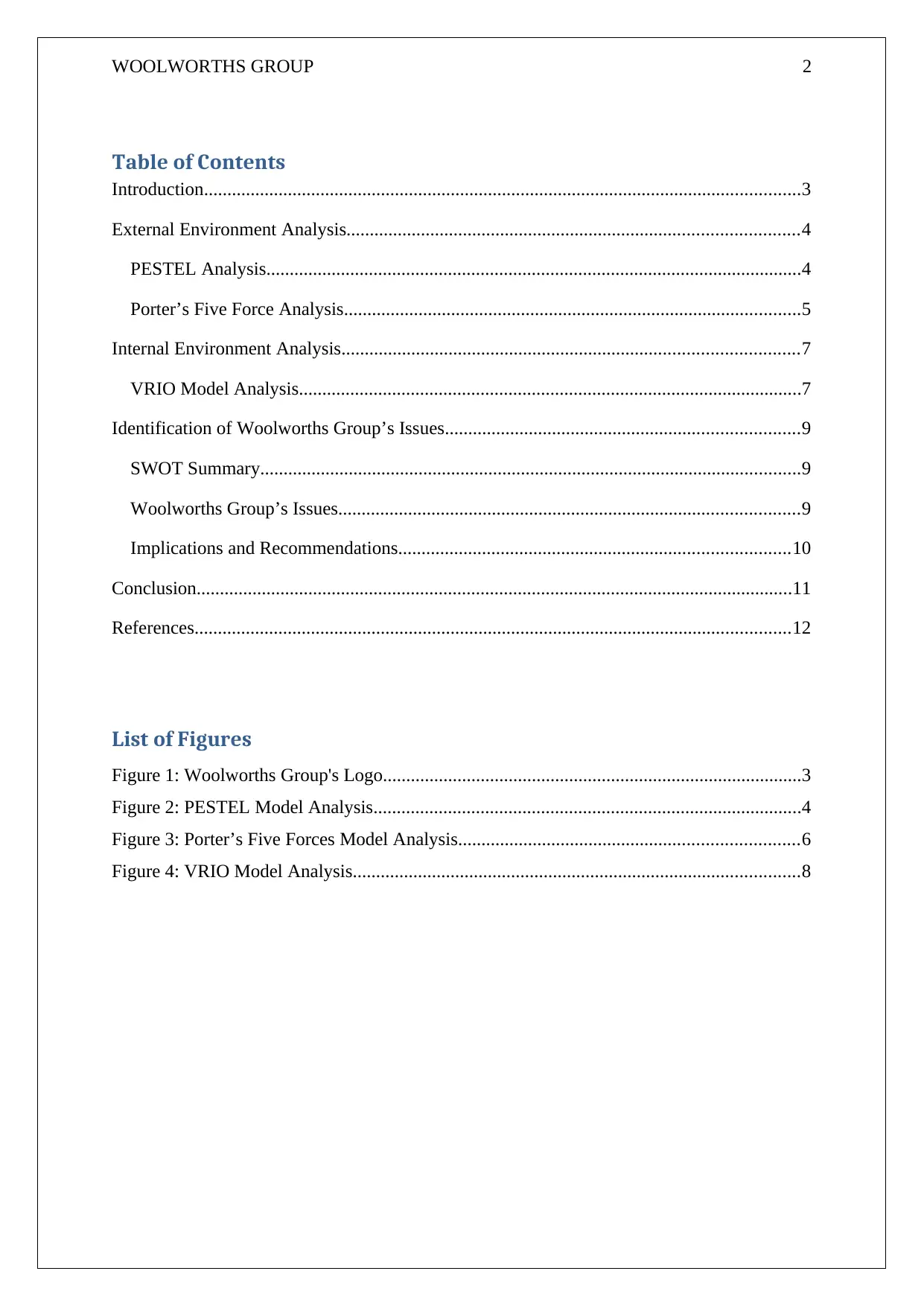
WOOLWORTHS GROUP 2
Table of Contents
Introduction................................................................................................................................3
External Environment Analysis.................................................................................................4
PESTEL Analysis...................................................................................................................4
Porter’s Five Force Analysis..................................................................................................5
Internal Environment Analysis..................................................................................................7
VRIO Model Analysis............................................................................................................7
Identification of Woolworths Group’s Issues............................................................................9
SWOT Summary....................................................................................................................9
Woolworths Group’s Issues...................................................................................................9
Implications and Recommendations....................................................................................10
Conclusion................................................................................................................................11
References................................................................................................................................12
List of Figures
Figure 1: Woolworths Group's Logo..........................................................................................3
Figure 2: PESTEL Model Analysis............................................................................................4
Figure 3: Porter’s Five Forces Model Analysis.........................................................................6
Figure 4: VRIO Model Analysis................................................................................................8
Table of Contents
Introduction................................................................................................................................3
External Environment Analysis.................................................................................................4
PESTEL Analysis...................................................................................................................4
Porter’s Five Force Analysis..................................................................................................5
Internal Environment Analysis..................................................................................................7
VRIO Model Analysis............................................................................................................7
Identification of Woolworths Group’s Issues............................................................................9
SWOT Summary....................................................................................................................9
Woolworths Group’s Issues...................................................................................................9
Implications and Recommendations....................................................................................10
Conclusion................................................................................................................................11
References................................................................................................................................12
List of Figures
Figure 1: Woolworths Group's Logo..........................................................................................3
Figure 2: PESTEL Model Analysis............................................................................................4
Figure 3: Porter’s Five Forces Model Analysis.........................................................................6
Figure 4: VRIO Model Analysis................................................................................................8
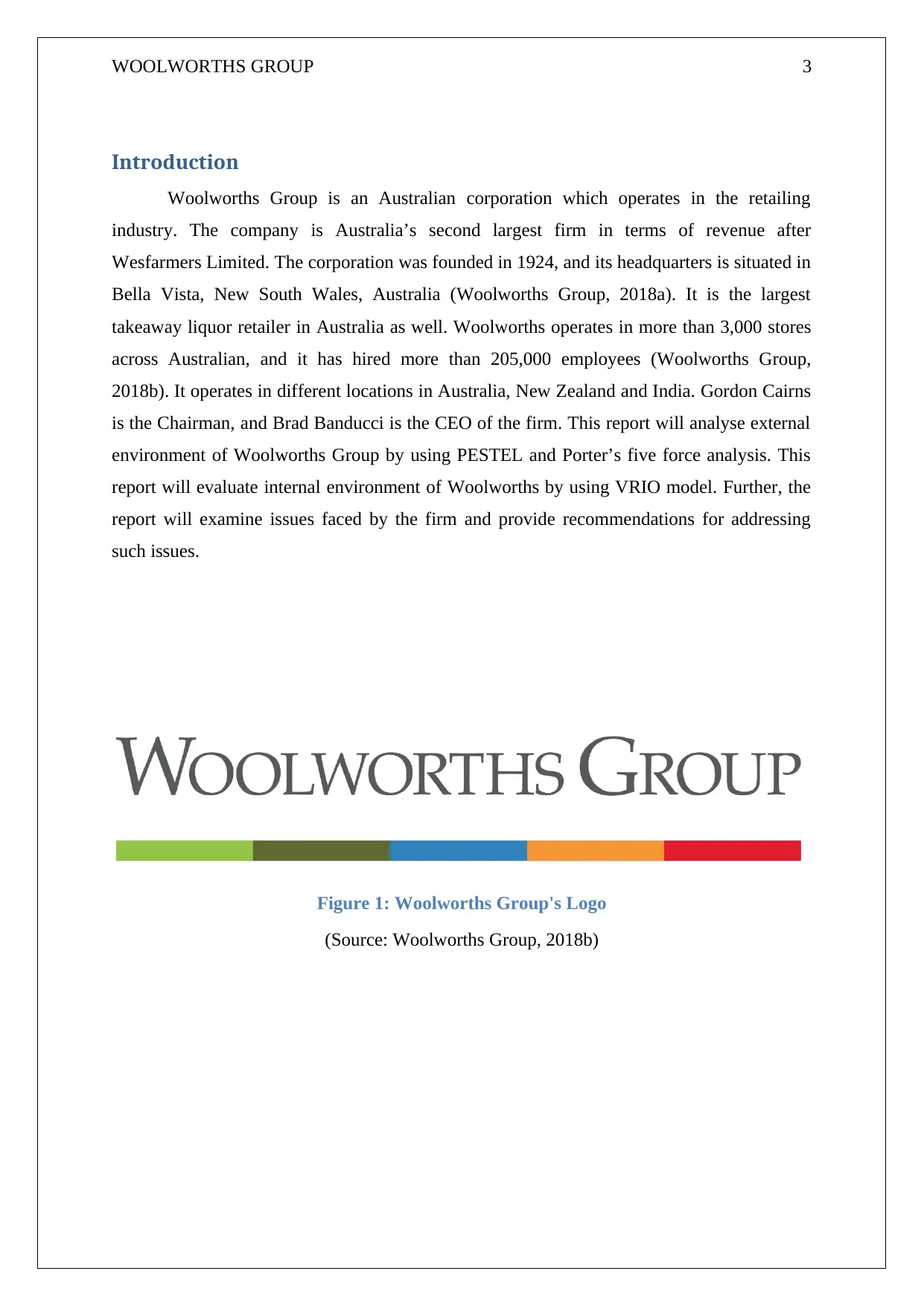
WOOLWORTHS GROUP 3
Introduction
Woolworths Group is an Australian corporation which operates in the retailing
industry. The company is Australia’s second largest firm in terms of revenue after
Wesfarmers Limited. The corporation was founded in 1924, and its headquarters is situated in
Bella Vista, New South Wales, Australia (Woolworths Group, 2018a). It is the largest
takeaway liquor retailer in Australia as well. Woolworths operates in more than 3,000 stores
across Australian, and it has hired more than 205,000 employees (Woolworths Group,
2018b). It operates in different locations in Australia, New Zealand and India. Gordon Cairns
is the Chairman, and Brad Banducci is the CEO of the firm. This report will analyse external
environment of Woolworths Group by using PESTEL and Porter’s five force analysis. This
report will evaluate internal environment of Woolworths by using VRIO model. Further, the
report will examine issues faced by the firm and provide recommendations for addressing
such issues.
Figure 1: Woolworths Group's Logo
(Source: Woolworths Group, 2018b)
Introduction
Woolworths Group is an Australian corporation which operates in the retailing
industry. The company is Australia’s second largest firm in terms of revenue after
Wesfarmers Limited. The corporation was founded in 1924, and its headquarters is situated in
Bella Vista, New South Wales, Australia (Woolworths Group, 2018a). It is the largest
takeaway liquor retailer in Australia as well. Woolworths operates in more than 3,000 stores
across Australian, and it has hired more than 205,000 employees (Woolworths Group,
2018b). It operates in different locations in Australia, New Zealand and India. Gordon Cairns
is the Chairman, and Brad Banducci is the CEO of the firm. This report will analyse external
environment of Woolworths Group by using PESTEL and Porter’s five force analysis. This
report will evaluate internal environment of Woolworths by using VRIO model. Further, the
report will examine issues faced by the firm and provide recommendations for addressing
such issues.
Figure 1: Woolworths Group's Logo
(Source: Woolworths Group, 2018b)
Secure Best Marks with AI Grader
Need help grading? Try our AI Grader for instant feedback on your assignments.
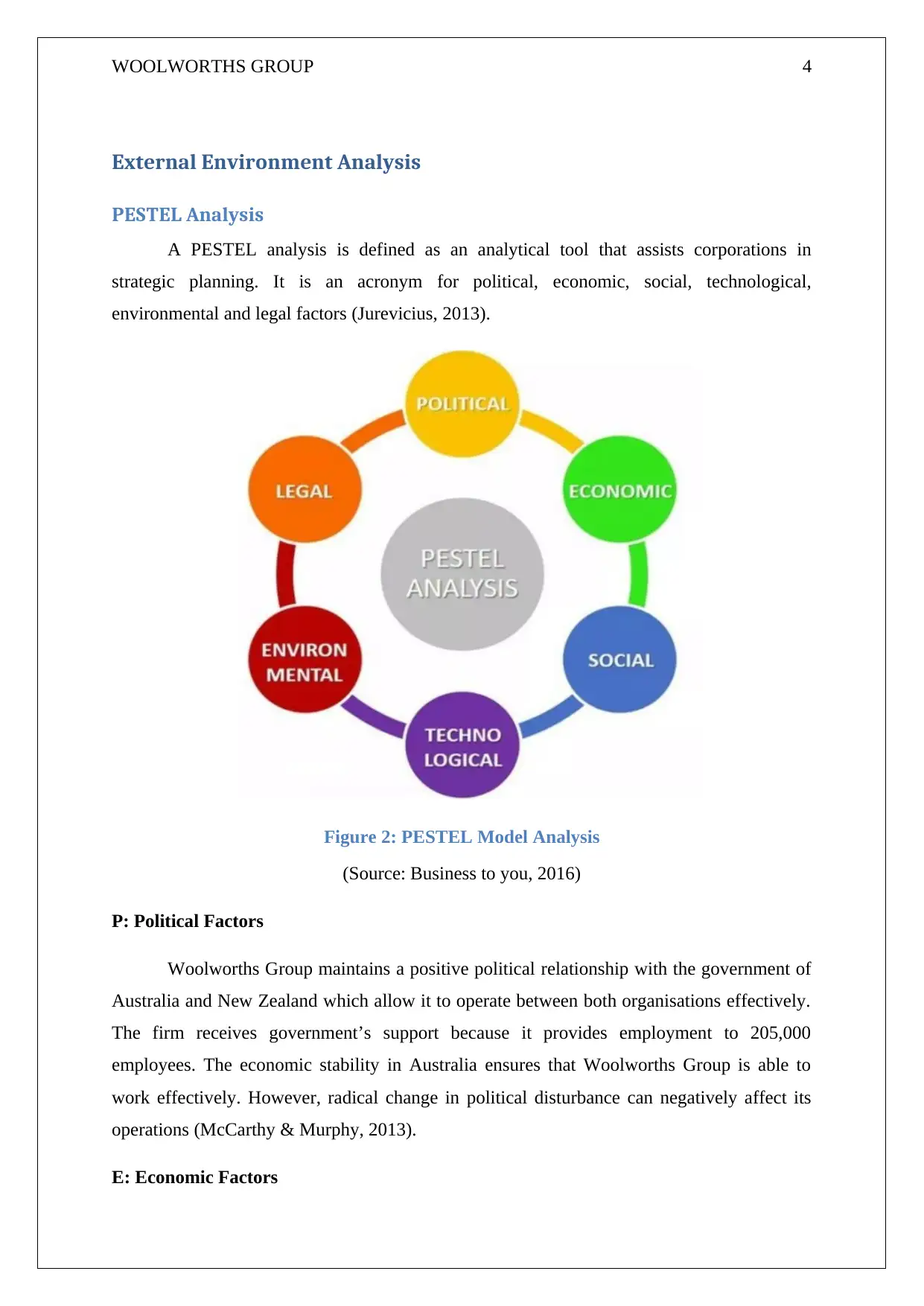
WOOLWORTHS GROUP 4
External Environment Analysis
PESTEL Analysis
A PESTEL analysis is defined as an analytical tool that assists corporations in
strategic planning. It is an acronym for political, economic, social, technological,
environmental and legal factors (Jurevicius, 2013).
Figure 2: PESTEL Model Analysis
(Source: Business to you, 2016)
P: Political Factors
Woolworths Group maintains a positive political relationship with the government of
Australia and New Zealand which allow it to operate between both organisations effectively.
The firm receives government’s support because it provides employment to 205,000
employees. The economic stability in Australia ensures that Woolworths Group is able to
work effectively. However, radical change in political disturbance can negatively affect its
operations (McCarthy & Murphy, 2013).
E: Economic Factors
External Environment Analysis
PESTEL Analysis
A PESTEL analysis is defined as an analytical tool that assists corporations in
strategic planning. It is an acronym for political, economic, social, technological,
environmental and legal factors (Jurevicius, 2013).
Figure 2: PESTEL Model Analysis
(Source: Business to you, 2016)
P: Political Factors
Woolworths Group maintains a positive political relationship with the government of
Australia and New Zealand which allow it to operate between both organisations effectively.
The firm receives government’s support because it provides employment to 205,000
employees. The economic stability in Australia ensures that Woolworths Group is able to
work effectively. However, radical change in political disturbance can negatively affect its
operations (McCarthy & Murphy, 2013).
E: Economic Factors

WOOLWORTHS GROUP 5
Mainly, Woolworths Group operates in Australia market, and the country’s stable
economic condition is suitable for its growth. However, in 2016, the firm reported a loss of
$1.235 billion due to a reduction in sales which occurred due to fierce competition and
recession. High unemployment rate in Australia also negatively effects Woolworths Group’s
operations since it is difficult for the company to hire talent employees (Griffith, Rodgers,
Thompson & Dart, 2009).
S: Social Factors
Woolworths Group focuses on providing high-level services to its customers by
offering quality products. The firm closely monitors change in customer preferences and
market trends while formulating its business strategies. Growing awareness regarding healthy
lifestyle is positive for the firm since it offers high-quality products to satisfy its customers’
demand (Richards, Kjaernes & Vik, 2016).
T: Technological Factors
Woolworths Group uses different technologies to improve its operations such as self-
checkout methods, online shopping facilities, Visa Pay Wave and others (Budmar, 2011). The
firm use technology to improve its operations in order to maintain efficiency and
effectiveness in the operations. Furthermore, it also uses IT system for improving the overall
experience of its customers. The firm also uses RFID technology in its supermarkets for
managing its operations and improving overall efficiency. However, the corporation failed to
effectively implement its online shopping services which caused a major delivery system
outage that made it customers angry (NEWS, 2017).
E: Environmental Factors
Woolworths Group complies with environmental regulations implemented by the
Australian government to ensure that it reduce its carbon footprint. The company takes part in
environment-related initiates for reducing environmental damages. The firm has planned to
establish a circular economy approach by 2020 which focuses on improved recyclability, use
of natural refrigerants, zero food waste and reduction in carbon emission (ASX, 2017).
L: Legal Factors
Woolworths Group complies with different legislative regulations implemented by the
Australian government relating to taxation policies, employment laws, workplace safety act,
Mainly, Woolworths Group operates in Australia market, and the country’s stable
economic condition is suitable for its growth. However, in 2016, the firm reported a loss of
$1.235 billion due to a reduction in sales which occurred due to fierce competition and
recession. High unemployment rate in Australia also negatively effects Woolworths Group’s
operations since it is difficult for the company to hire talent employees (Griffith, Rodgers,
Thompson & Dart, 2009).
S: Social Factors
Woolworths Group focuses on providing high-level services to its customers by
offering quality products. The firm closely monitors change in customer preferences and
market trends while formulating its business strategies. Growing awareness regarding healthy
lifestyle is positive for the firm since it offers high-quality products to satisfy its customers’
demand (Richards, Kjaernes & Vik, 2016).
T: Technological Factors
Woolworths Group uses different technologies to improve its operations such as self-
checkout methods, online shopping facilities, Visa Pay Wave and others (Budmar, 2011). The
firm use technology to improve its operations in order to maintain efficiency and
effectiveness in the operations. Furthermore, it also uses IT system for improving the overall
experience of its customers. The firm also uses RFID technology in its supermarkets for
managing its operations and improving overall efficiency. However, the corporation failed to
effectively implement its online shopping services which caused a major delivery system
outage that made it customers angry (NEWS, 2017).
E: Environmental Factors
Woolworths Group complies with environmental regulations implemented by the
Australian government to ensure that it reduce its carbon footprint. The company takes part in
environment-related initiates for reducing environmental damages. The firm has planned to
establish a circular economy approach by 2020 which focuses on improved recyclability, use
of natural refrigerants, zero food waste and reduction in carbon emission (ASX, 2017).
L: Legal Factors
Woolworths Group complies with different legislative regulations implemented by the
Australian government relating to taxation policies, employment laws, workplace safety act,
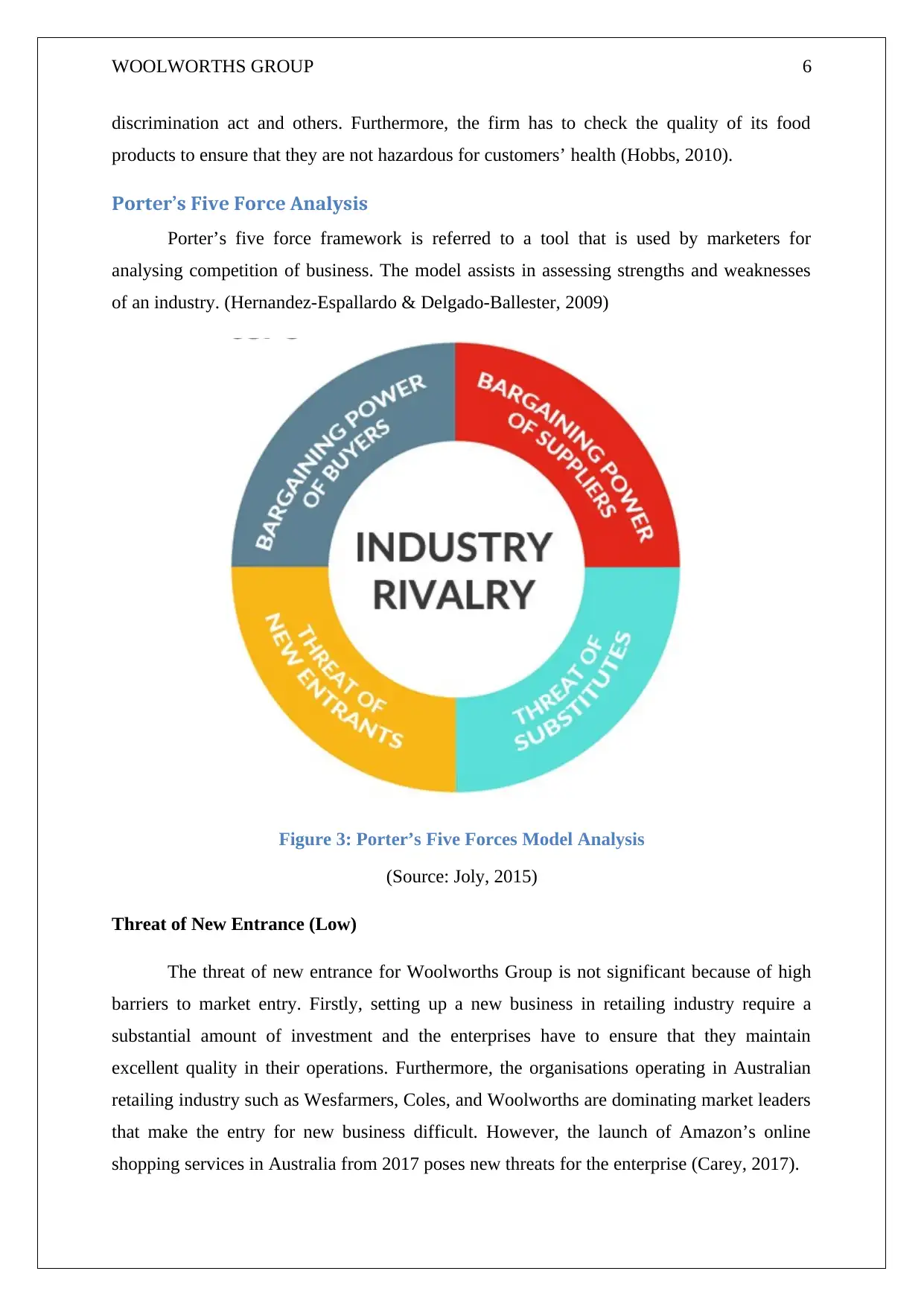
WOOLWORTHS GROUP 6
discrimination act and others. Furthermore, the firm has to check the quality of its food
products to ensure that they are not hazardous for customers’ health (Hobbs, 2010).
Porter’s Five Force Analysis
Porter’s five force framework is referred to a tool that is used by marketers for
analysing competition of business. The model assists in assessing strengths and weaknesses
of an industry. (Hernandez-Espallardo & Delgado-Ballester, 2009)
Figure 3: Porter’s Five Forces Model Analysis
(Source: Joly, 2015)
Threat of New Entrance (Low)
The threat of new entrance for Woolworths Group is not significant because of high
barriers to market entry. Firstly, setting up a new business in retailing industry require a
substantial amount of investment and the enterprises have to ensure that they maintain
excellent quality in their operations. Furthermore, the organisations operating in Australian
retailing industry such as Wesfarmers, Coles, and Woolworths are dominating market leaders
that make the entry for new business difficult. However, the launch of Amazon’s online
shopping services in Australia from 2017 poses new threats for the enterprise (Carey, 2017).
discrimination act and others. Furthermore, the firm has to check the quality of its food
products to ensure that they are not hazardous for customers’ health (Hobbs, 2010).
Porter’s Five Force Analysis
Porter’s five force framework is referred to a tool that is used by marketers for
analysing competition of business. The model assists in assessing strengths and weaknesses
of an industry. (Hernandez-Espallardo & Delgado-Ballester, 2009)
Figure 3: Porter’s Five Forces Model Analysis
(Source: Joly, 2015)
Threat of New Entrance (Low)
The threat of new entrance for Woolworths Group is not significant because of high
barriers to market entry. Firstly, setting up a new business in retailing industry require a
substantial amount of investment and the enterprises have to ensure that they maintain
excellent quality in their operations. Furthermore, the organisations operating in Australian
retailing industry such as Wesfarmers, Coles, and Woolworths are dominating market leaders
that make the entry for new business difficult. However, the launch of Amazon’s online
shopping services in Australia from 2017 poses new threats for the enterprise (Carey, 2017).
Paraphrase This Document
Need a fresh take? Get an instant paraphrase of this document with our AI Paraphraser
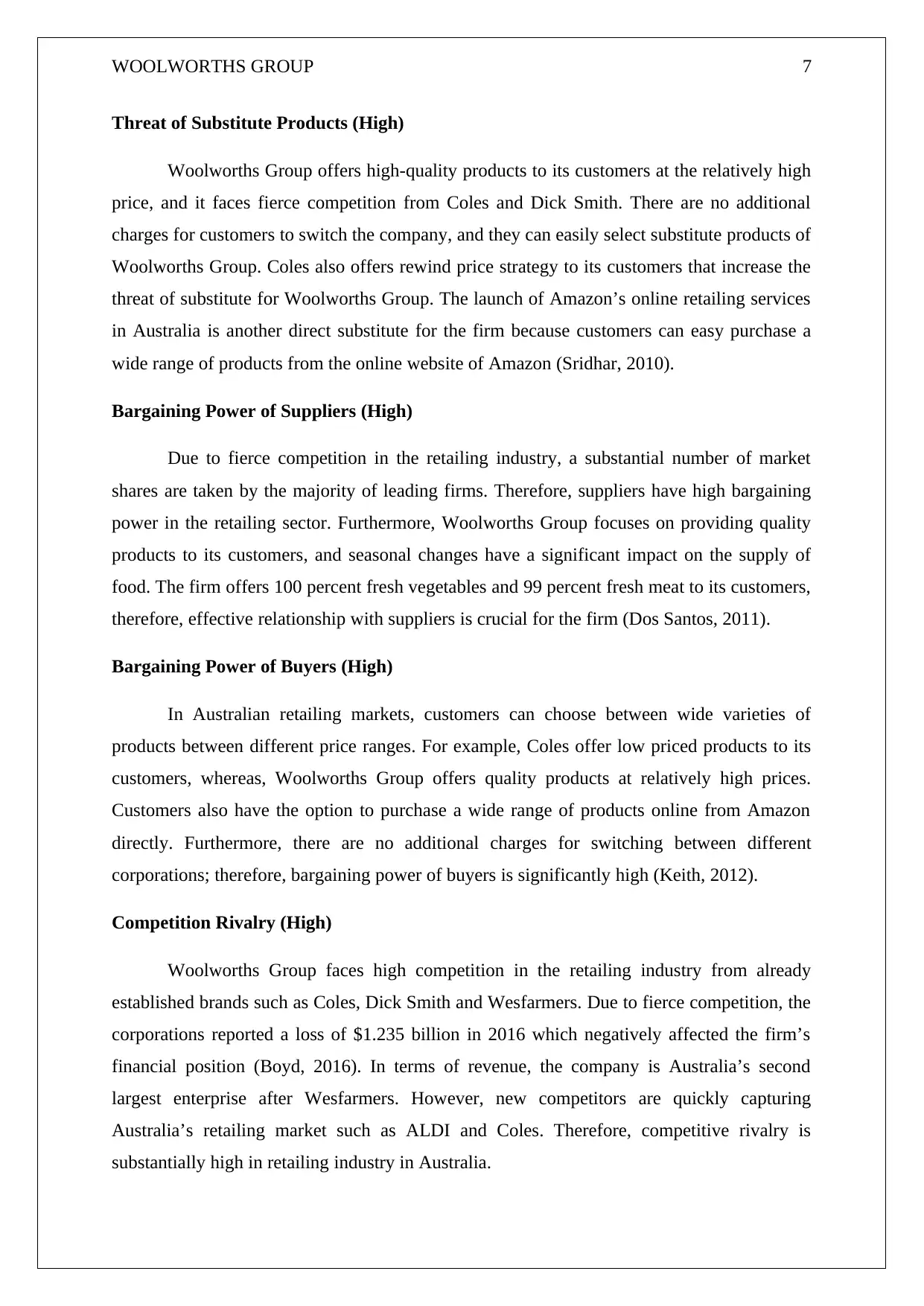
WOOLWORTHS GROUP 7
Threat of Substitute Products (High)
Woolworths Group offers high-quality products to its customers at the relatively high
price, and it faces fierce competition from Coles and Dick Smith. There are no additional
charges for customers to switch the company, and they can easily select substitute products of
Woolworths Group. Coles also offers rewind price strategy to its customers that increase the
threat of substitute for Woolworths Group. The launch of Amazon’s online retailing services
in Australia is another direct substitute for the firm because customers can easy purchase a
wide range of products from the online website of Amazon (Sridhar, 2010).
Bargaining Power of Suppliers (High)
Due to fierce competition in the retailing industry, a substantial number of market
shares are taken by the majority of leading firms. Therefore, suppliers have high bargaining
power in the retailing sector. Furthermore, Woolworths Group focuses on providing quality
products to its customers, and seasonal changes have a significant impact on the supply of
food. The firm offers 100 percent fresh vegetables and 99 percent fresh meat to its customers,
therefore, effective relationship with suppliers is crucial for the firm (Dos Santos, 2011).
Bargaining Power of Buyers (High)
In Australian retailing markets, customers can choose between wide varieties of
products between different price ranges. For example, Coles offer low priced products to its
customers, whereas, Woolworths Group offers quality products at relatively high prices.
Customers also have the option to purchase a wide range of products online from Amazon
directly. Furthermore, there are no additional charges for switching between different
corporations; therefore, bargaining power of buyers is significantly high (Keith, 2012).
Competition Rivalry (High)
Woolworths Group faces high competition in the retailing industry from already
established brands such as Coles, Dick Smith and Wesfarmers. Due to fierce competition, the
corporations reported a loss of $1.235 billion in 2016 which negatively affected the firm’s
financial position (Boyd, 2016). In terms of revenue, the company is Australia’s second
largest enterprise after Wesfarmers. However, new competitors are quickly capturing
Australia’s retailing market such as ALDI and Coles. Therefore, competitive rivalry is
substantially high in retailing industry in Australia.
Threat of Substitute Products (High)
Woolworths Group offers high-quality products to its customers at the relatively high
price, and it faces fierce competition from Coles and Dick Smith. There are no additional
charges for customers to switch the company, and they can easily select substitute products of
Woolworths Group. Coles also offers rewind price strategy to its customers that increase the
threat of substitute for Woolworths Group. The launch of Amazon’s online retailing services
in Australia is another direct substitute for the firm because customers can easy purchase a
wide range of products from the online website of Amazon (Sridhar, 2010).
Bargaining Power of Suppliers (High)
Due to fierce competition in the retailing industry, a substantial number of market
shares are taken by the majority of leading firms. Therefore, suppliers have high bargaining
power in the retailing sector. Furthermore, Woolworths Group focuses on providing quality
products to its customers, and seasonal changes have a significant impact on the supply of
food. The firm offers 100 percent fresh vegetables and 99 percent fresh meat to its customers,
therefore, effective relationship with suppliers is crucial for the firm (Dos Santos, 2011).
Bargaining Power of Buyers (High)
In Australian retailing markets, customers can choose between wide varieties of
products between different price ranges. For example, Coles offer low priced products to its
customers, whereas, Woolworths Group offers quality products at relatively high prices.
Customers also have the option to purchase a wide range of products online from Amazon
directly. Furthermore, there are no additional charges for switching between different
corporations; therefore, bargaining power of buyers is significantly high (Keith, 2012).
Competition Rivalry (High)
Woolworths Group faces high competition in the retailing industry from already
established brands such as Coles, Dick Smith and Wesfarmers. Due to fierce competition, the
corporations reported a loss of $1.235 billion in 2016 which negatively affected the firm’s
financial position (Boyd, 2016). In terms of revenue, the company is Australia’s second
largest enterprise after Wesfarmers. However, new competitors are quickly capturing
Australia’s retailing market such as ALDI and Coles. Therefore, competitive rivalry is
substantially high in retailing industry in Australia.
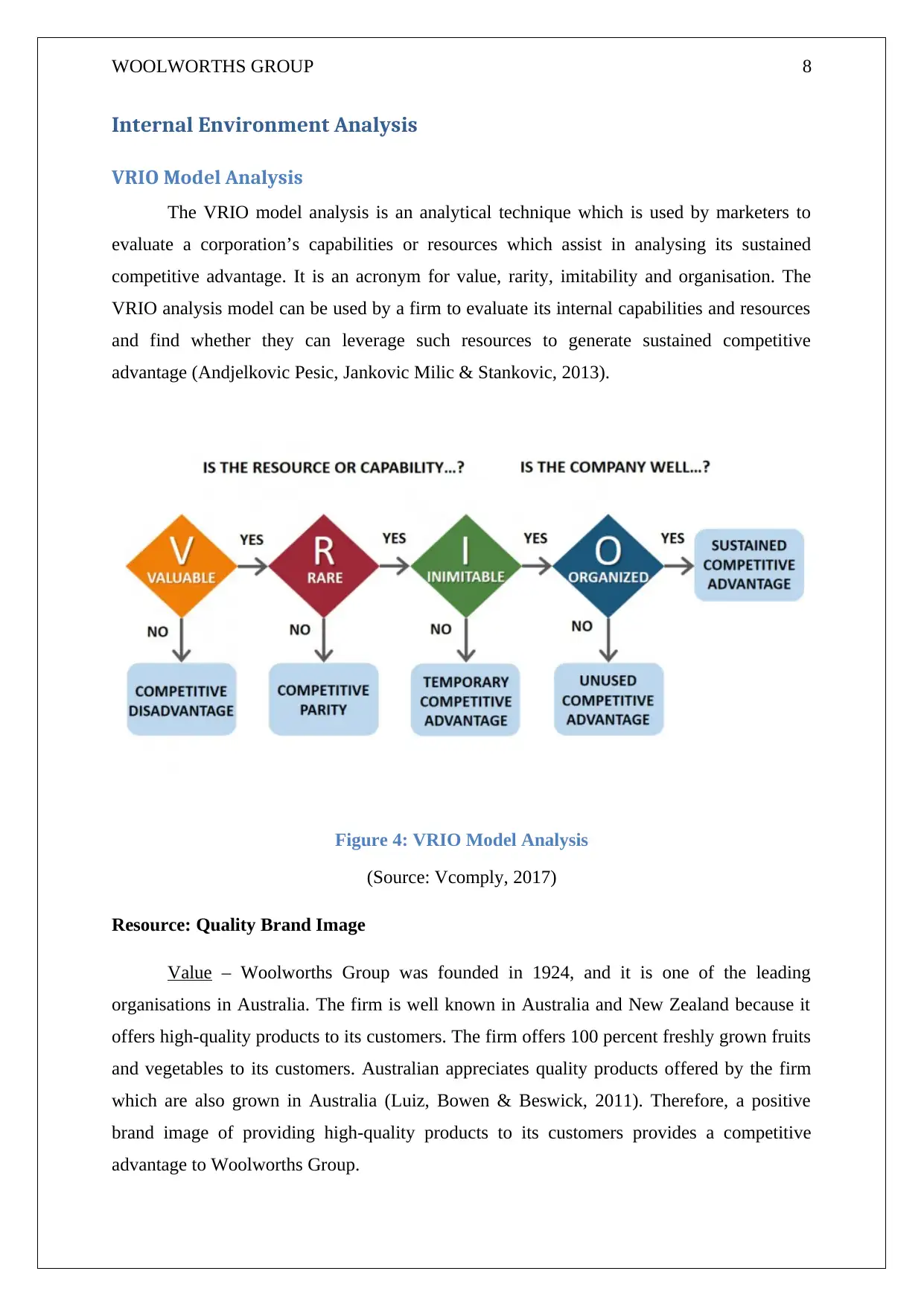
WOOLWORTHS GROUP 8
Internal Environment Analysis
VRIO Model Analysis
The VRIO model analysis is an analytical technique which is used by marketers to
evaluate a corporation’s capabilities or resources which assist in analysing its sustained
competitive advantage. It is an acronym for value, rarity, imitability and organisation. The
VRIO analysis model can be used by a firm to evaluate its internal capabilities and resources
and find whether they can leverage such resources to generate sustained competitive
advantage (Andjelkovic Pesic, Jankovic Milic & Stankovic, 2013).
Figure 4: VRIO Model Analysis
(Source: Vcomply, 2017)
Resource: Quality Brand Image
Value – Woolworths Group was founded in 1924, and it is one of the leading
organisations in Australia. The firm is well known in Australia and New Zealand because it
offers high-quality products to its customers. The firm offers 100 percent freshly grown fruits
and vegetables to its customers. Australian appreciates quality products offered by the firm
which are also grown in Australia (Luiz, Bowen & Beswick, 2011). Therefore, a positive
brand image of providing high-quality products to its customers provides a competitive
advantage to Woolworths Group.
Internal Environment Analysis
VRIO Model Analysis
The VRIO model analysis is an analytical technique which is used by marketers to
evaluate a corporation’s capabilities or resources which assist in analysing its sustained
competitive advantage. It is an acronym for value, rarity, imitability and organisation. The
VRIO analysis model can be used by a firm to evaluate its internal capabilities and resources
and find whether they can leverage such resources to generate sustained competitive
advantage (Andjelkovic Pesic, Jankovic Milic & Stankovic, 2013).
Figure 4: VRIO Model Analysis
(Source: Vcomply, 2017)
Resource: Quality Brand Image
Value – Woolworths Group was founded in 1924, and it is one of the leading
organisations in Australia. The firm is well known in Australia and New Zealand because it
offers high-quality products to its customers. The firm offers 100 percent freshly grown fruits
and vegetables to its customers. Australian appreciates quality products offered by the firm
which are also grown in Australia (Luiz, Bowen & Beswick, 2011). Therefore, a positive
brand image of providing high-quality products to its customers provides a competitive
advantage to Woolworths Group.
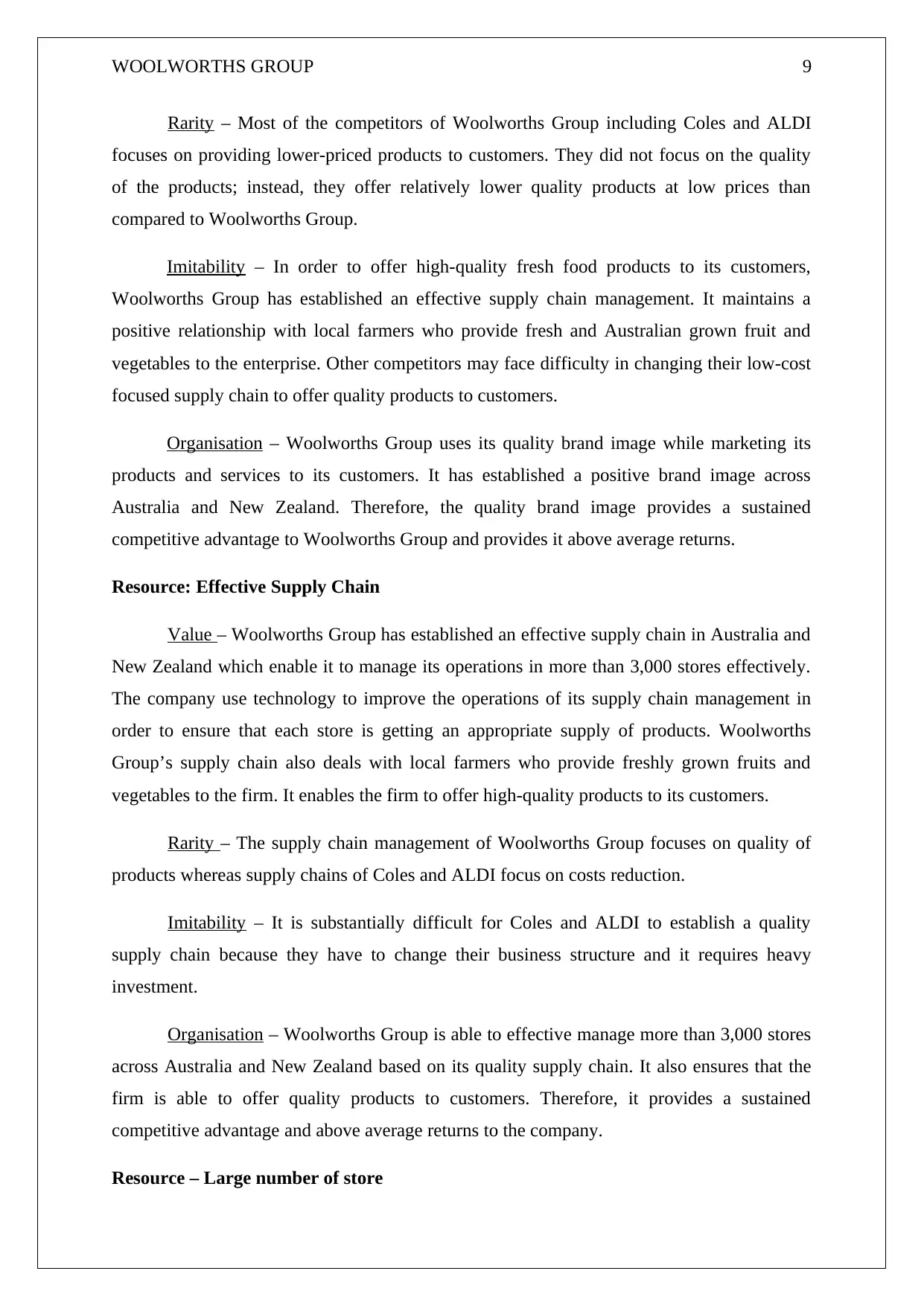
WOOLWORTHS GROUP 9
Rarity – Most of the competitors of Woolworths Group including Coles and ALDI
focuses on providing lower-priced products to customers. They did not focus on the quality
of the products; instead, they offer relatively lower quality products at low prices than
compared to Woolworths Group.
Imitability – In order to offer high-quality fresh food products to its customers,
Woolworths Group has established an effective supply chain management. It maintains a
positive relationship with local farmers who provide fresh and Australian grown fruit and
vegetables to the enterprise. Other competitors may face difficulty in changing their low-cost
focused supply chain to offer quality products to customers.
Organisation – Woolworths Group uses its quality brand image while marketing its
products and services to its customers. It has established a positive brand image across
Australia and New Zealand. Therefore, the quality brand image provides a sustained
competitive advantage to Woolworths Group and provides it above average returns.
Resource: Effective Supply Chain
Value – Woolworths Group has established an effective supply chain in Australia and
New Zealand which enable it to manage its operations in more than 3,000 stores effectively.
The company use technology to improve the operations of its supply chain management in
order to ensure that each store is getting an appropriate supply of products. Woolworths
Group’s supply chain also deals with local farmers who provide freshly grown fruits and
vegetables to the firm. It enables the firm to offer high-quality products to its customers.
Rarity – The supply chain management of Woolworths Group focuses on quality of
products whereas supply chains of Coles and ALDI focus on costs reduction.
Imitability – It is substantially difficult for Coles and ALDI to establish a quality
supply chain because they have to change their business structure and it requires heavy
investment.
Organisation – Woolworths Group is able to effective manage more than 3,000 stores
across Australia and New Zealand based on its quality supply chain. It also ensures that the
firm is able to offer quality products to customers. Therefore, it provides a sustained
competitive advantage and above average returns to the company.
Resource – Large number of store
Rarity – Most of the competitors of Woolworths Group including Coles and ALDI
focuses on providing lower-priced products to customers. They did not focus on the quality
of the products; instead, they offer relatively lower quality products at low prices than
compared to Woolworths Group.
Imitability – In order to offer high-quality fresh food products to its customers,
Woolworths Group has established an effective supply chain management. It maintains a
positive relationship with local farmers who provide fresh and Australian grown fruit and
vegetables to the enterprise. Other competitors may face difficulty in changing their low-cost
focused supply chain to offer quality products to customers.
Organisation – Woolworths Group uses its quality brand image while marketing its
products and services to its customers. It has established a positive brand image across
Australia and New Zealand. Therefore, the quality brand image provides a sustained
competitive advantage to Woolworths Group and provides it above average returns.
Resource: Effective Supply Chain
Value – Woolworths Group has established an effective supply chain in Australia and
New Zealand which enable it to manage its operations in more than 3,000 stores effectively.
The company use technology to improve the operations of its supply chain management in
order to ensure that each store is getting an appropriate supply of products. Woolworths
Group’s supply chain also deals with local farmers who provide freshly grown fruits and
vegetables to the firm. It enables the firm to offer high-quality products to its customers.
Rarity – The supply chain management of Woolworths Group focuses on quality of
products whereas supply chains of Coles and ALDI focus on costs reduction.
Imitability – It is substantially difficult for Coles and ALDI to establish a quality
supply chain because they have to change their business structure and it requires heavy
investment.
Organisation – Woolworths Group is able to effective manage more than 3,000 stores
across Australia and New Zealand based on its quality supply chain. It also ensures that the
firm is able to offer quality products to customers. Therefore, it provides a sustained
competitive advantage and above average returns to the company.
Resource – Large number of store
Secure Best Marks with AI Grader
Need help grading? Try our AI Grader for instant feedback on your assignments.
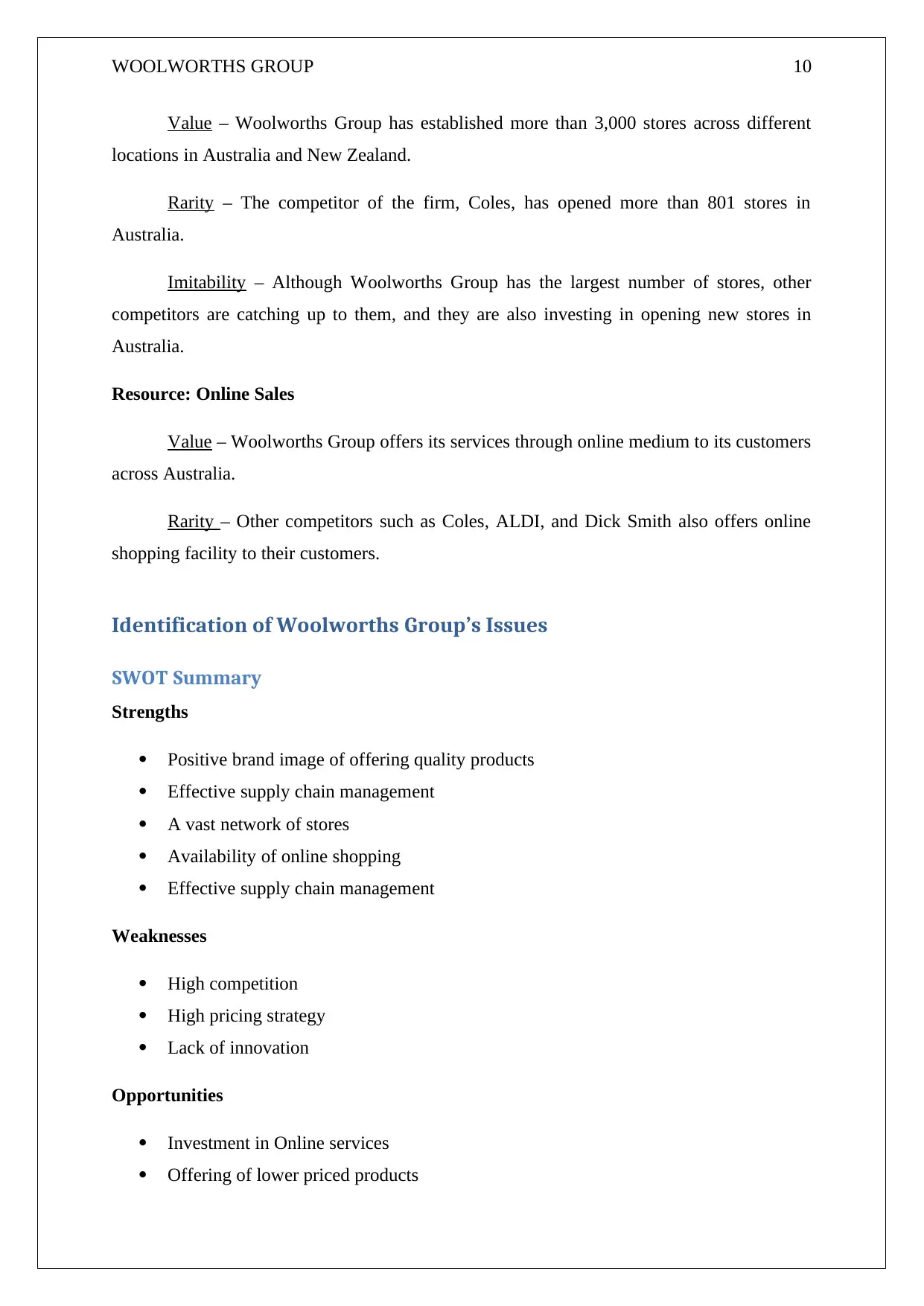
WOOLWORTHS GROUP 10
Value – Woolworths Group has established more than 3,000 stores across different
locations in Australia and New Zealand.
Rarity – The competitor of the firm, Coles, has opened more than 801 stores in
Australia.
Imitability – Although Woolworths Group has the largest number of stores, other
competitors are catching up to them, and they are also investing in opening new stores in
Australia.
Resource: Online Sales
Value – Woolworths Group offers its services through online medium to its customers
across Australia.
Rarity – Other competitors such as Coles, ALDI, and Dick Smith also offers online
shopping facility to their customers.
Identification of Woolworths Group’s Issues
SWOT Summary
Strengths
Positive brand image of offering quality products
Effective supply chain management
A vast network of stores
Availability of online shopping
Effective supply chain management
Weaknesses
High competition
High pricing strategy
Lack of innovation
Opportunities
Investment in Online services
Offering of lower priced products
Value – Woolworths Group has established more than 3,000 stores across different
locations in Australia and New Zealand.
Rarity – The competitor of the firm, Coles, has opened more than 801 stores in
Australia.
Imitability – Although Woolworths Group has the largest number of stores, other
competitors are catching up to them, and they are also investing in opening new stores in
Australia.
Resource: Online Sales
Value – Woolworths Group offers its services through online medium to its customers
across Australia.
Rarity – Other competitors such as Coles, ALDI, and Dick Smith also offers online
shopping facility to their customers.
Identification of Woolworths Group’s Issues
SWOT Summary
Strengths
Positive brand image of offering quality products
Effective supply chain management
A vast network of stores
Availability of online shopping
Effective supply chain management
Weaknesses
High competition
High pricing strategy
Lack of innovation
Opportunities
Investment in Online services
Offering of lower priced products
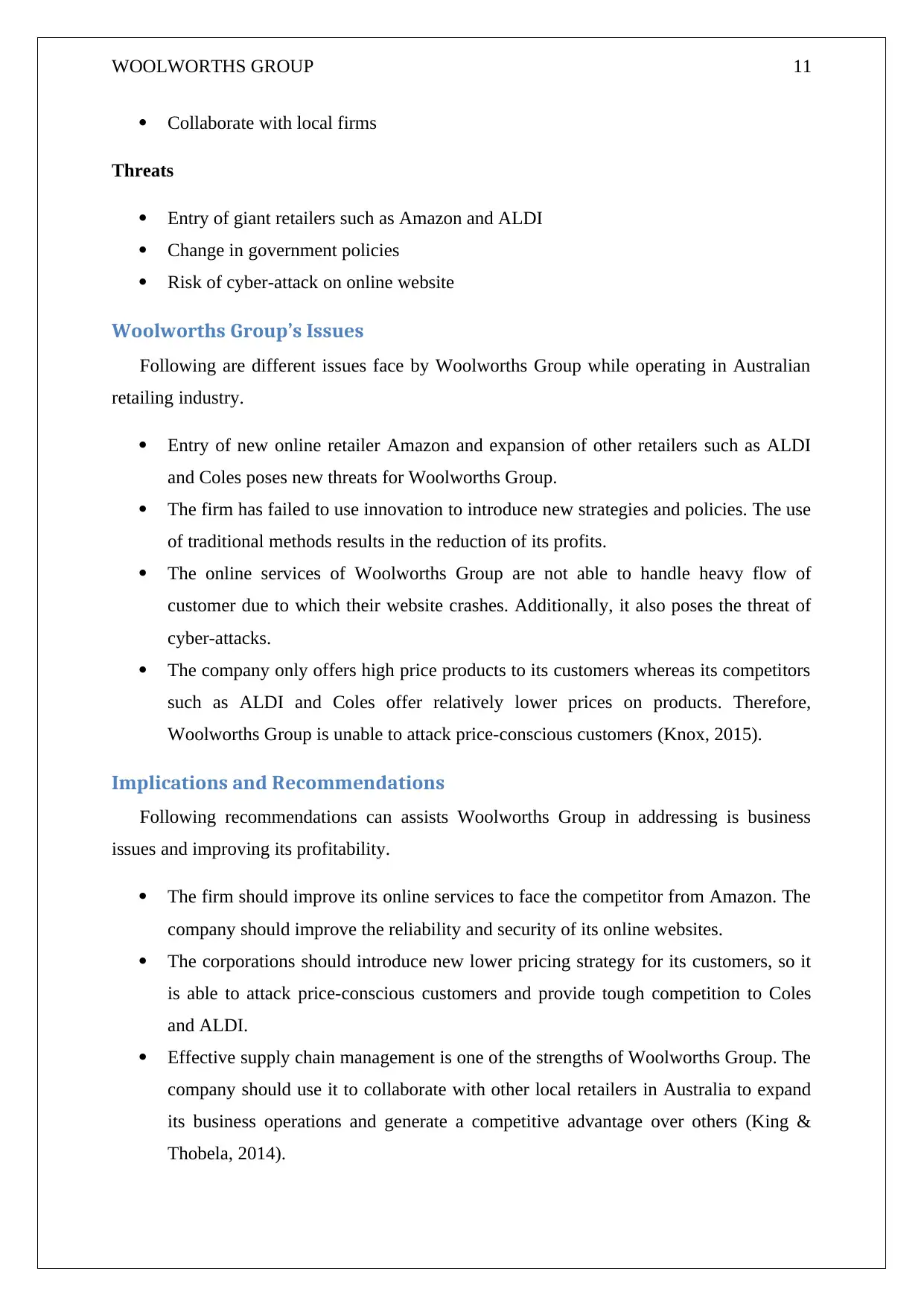
WOOLWORTHS GROUP 11
Collaborate with local firms
Threats
Entry of giant retailers such as Amazon and ALDI
Change in government policies
Risk of cyber-attack on online website
Woolworths Group’s Issues
Following are different issues face by Woolworths Group while operating in Australian
retailing industry.
Entry of new online retailer Amazon and expansion of other retailers such as ALDI
and Coles poses new threats for Woolworths Group.
The firm has failed to use innovation to introduce new strategies and policies. The use
of traditional methods results in the reduction of its profits.
The online services of Woolworths Group are not able to handle heavy flow of
customer due to which their website crashes. Additionally, it also poses the threat of
cyber-attacks.
The company only offers high price products to its customers whereas its competitors
such as ALDI and Coles offer relatively lower prices on products. Therefore,
Woolworths Group is unable to attack price-conscious customers (Knox, 2015).
Implications and Recommendations
Following recommendations can assists Woolworths Group in addressing is business
issues and improving its profitability.
The firm should improve its online services to face the competitor from Amazon. The
company should improve the reliability and security of its online websites.
The corporations should introduce new lower pricing strategy for its customers, so it
is able to attack price-conscious customers and provide tough competition to Coles
and ALDI.
Effective supply chain management is one of the strengths of Woolworths Group. The
company should use it to collaborate with other local retailers in Australia to expand
its business operations and generate a competitive advantage over others (King &
Thobela, 2014).
Collaborate with local firms
Threats
Entry of giant retailers such as Amazon and ALDI
Change in government policies
Risk of cyber-attack on online website
Woolworths Group’s Issues
Following are different issues face by Woolworths Group while operating in Australian
retailing industry.
Entry of new online retailer Amazon and expansion of other retailers such as ALDI
and Coles poses new threats for Woolworths Group.
The firm has failed to use innovation to introduce new strategies and policies. The use
of traditional methods results in the reduction of its profits.
The online services of Woolworths Group are not able to handle heavy flow of
customer due to which their website crashes. Additionally, it also poses the threat of
cyber-attacks.
The company only offers high price products to its customers whereas its competitors
such as ALDI and Coles offer relatively lower prices on products. Therefore,
Woolworths Group is unable to attack price-conscious customers (Knox, 2015).
Implications and Recommendations
Following recommendations can assists Woolworths Group in addressing is business
issues and improving its profitability.
The firm should improve its online services to face the competitor from Amazon. The
company should improve the reliability and security of its online websites.
The corporations should introduce new lower pricing strategy for its customers, so it
is able to attack price-conscious customers and provide tough competition to Coles
and ALDI.
Effective supply chain management is one of the strengths of Woolworths Group. The
company should use it to collaborate with other local retailers in Australia to expand
its business operations and generate a competitive advantage over others (King &
Thobela, 2014).
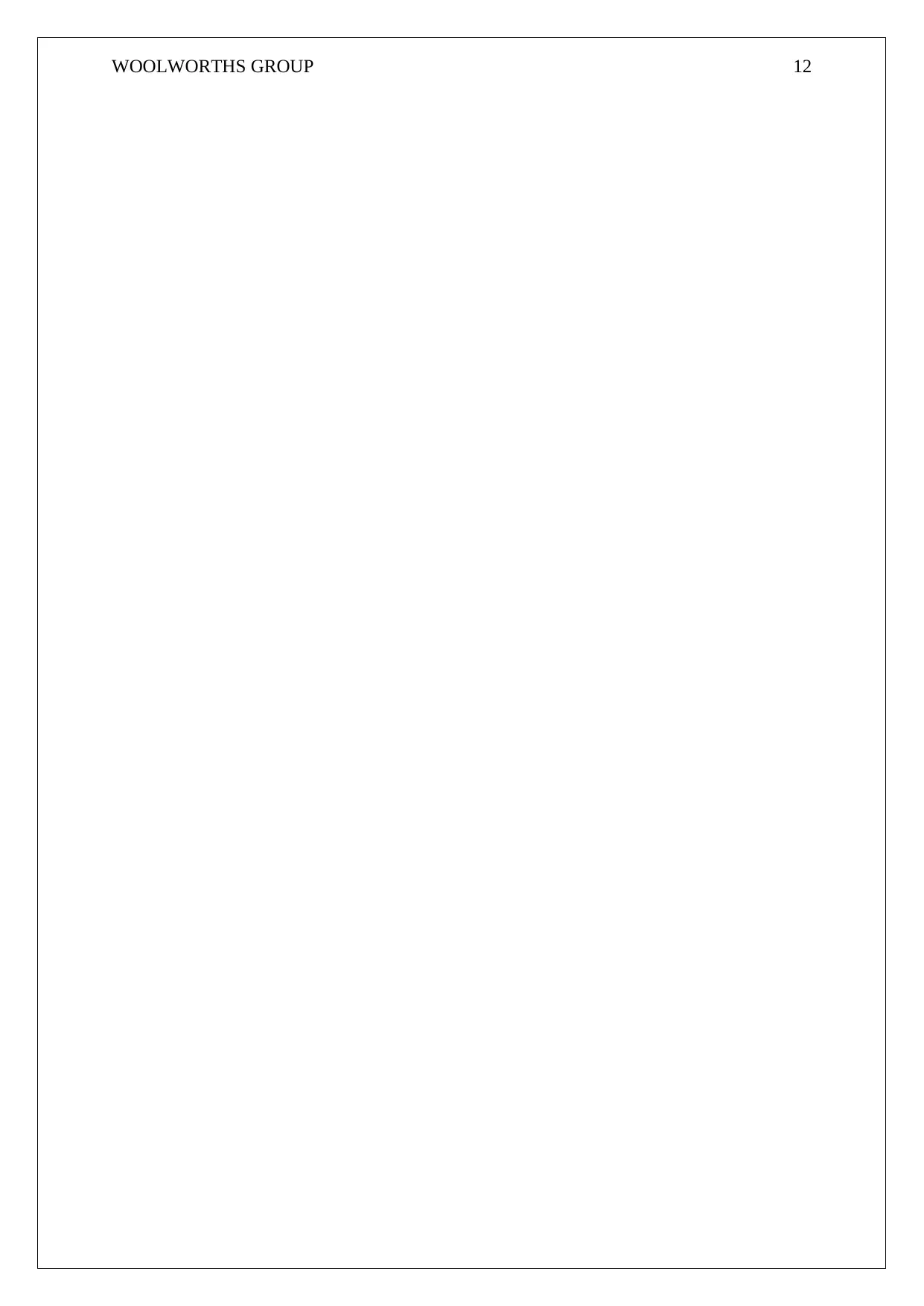
WOOLWORTHS GROUP 12
Paraphrase This Document
Need a fresh take? Get an instant paraphrase of this document with our AI Paraphraser
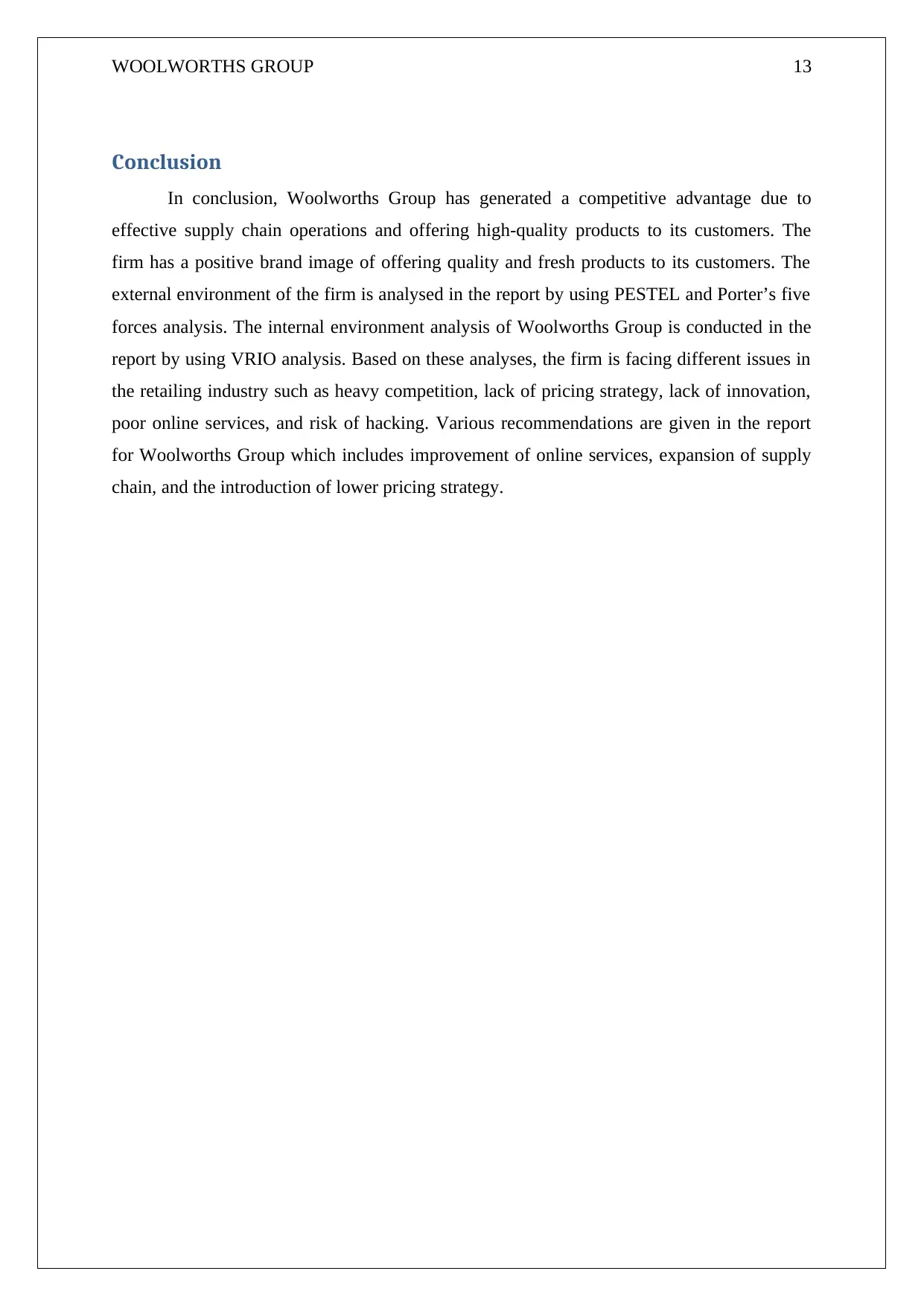
WOOLWORTHS GROUP 13
Conclusion
In conclusion, Woolworths Group has generated a competitive advantage due to
effective supply chain operations and offering high-quality products to its customers. The
firm has a positive brand image of offering quality and fresh products to its customers. The
external environment of the firm is analysed in the report by using PESTEL and Porter’s five
forces analysis. The internal environment analysis of Woolworths Group is conducted in the
report by using VRIO analysis. Based on these analyses, the firm is facing different issues in
the retailing industry such as heavy competition, lack of pricing strategy, lack of innovation,
poor online services, and risk of hacking. Various recommendations are given in the report
for Woolworths Group which includes improvement of online services, expansion of supply
chain, and the introduction of lower pricing strategy.
Conclusion
In conclusion, Woolworths Group has generated a competitive advantage due to
effective supply chain operations and offering high-quality products to its customers. The
firm has a positive brand image of offering quality and fresh products to its customers. The
external environment of the firm is analysed in the report by using PESTEL and Porter’s five
forces analysis. The internal environment analysis of Woolworths Group is conducted in the
report by using VRIO analysis. Based on these analyses, the firm is facing different issues in
the retailing industry such as heavy competition, lack of pricing strategy, lack of innovation,
poor online services, and risk of hacking. Various recommendations are given in the report
for Woolworths Group which includes improvement of online services, expansion of supply
chain, and the introduction of lower pricing strategy.
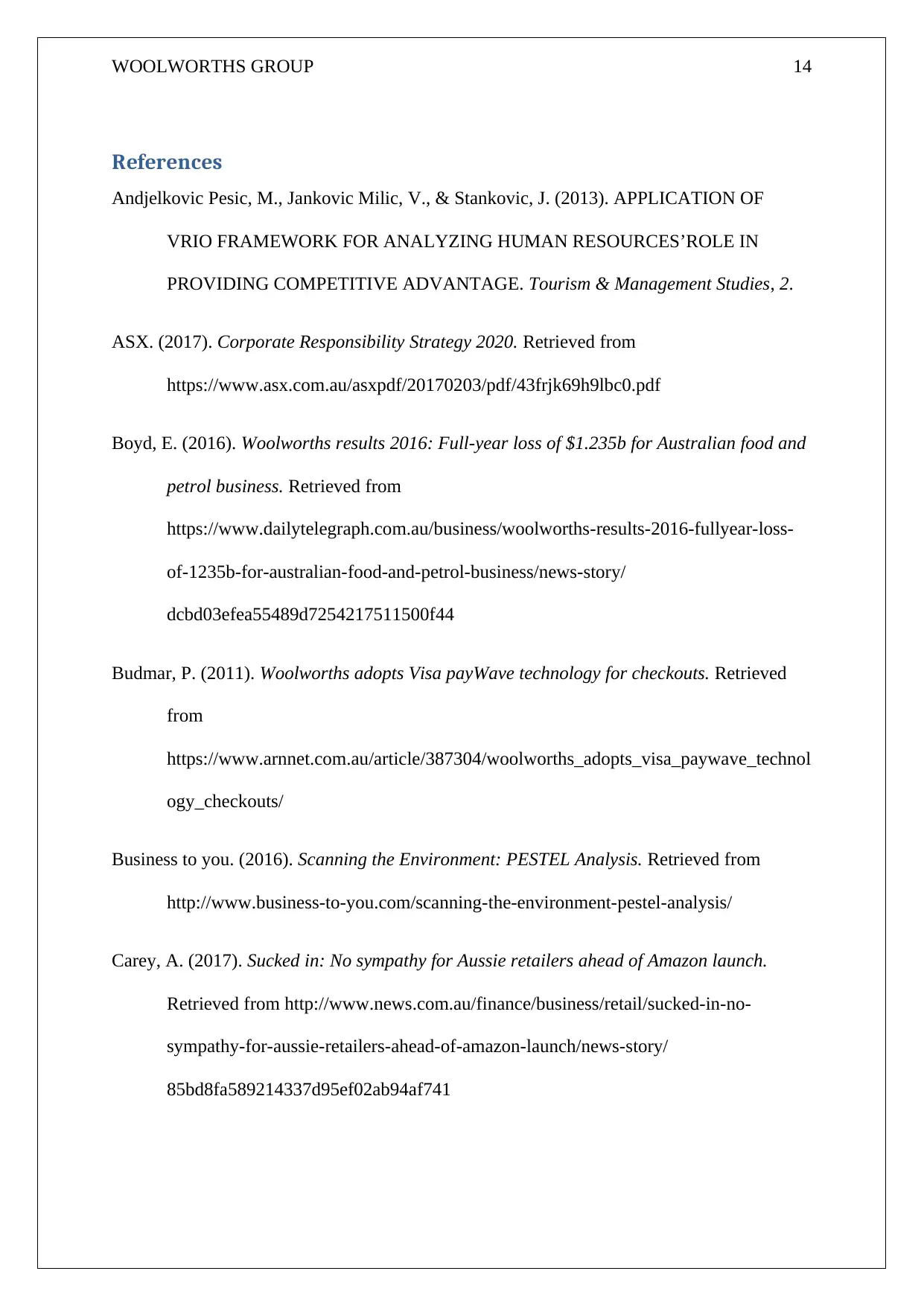
WOOLWORTHS GROUP 14
References
Andjelkovic Pesic, M., Jankovic Milic, V., & Stankovic, J. (2013). APPLICATION OF
VRIO FRAMEWORK FOR ANALYZING HUMAN RESOURCES’ROLE IN
PROVIDING COMPETITIVE ADVANTAGE. Tourism & Management Studies, 2.
ASX. (2017). Corporate Responsibility Strategy 2020. Retrieved from
https://www.asx.com.au/asxpdf/20170203/pdf/43frjk69h9lbc0.pdf
Boyd, E. (2016). Woolworths results 2016: Full-year loss of $1.235b for Australian food and
petrol business. Retrieved from
https://www.dailytelegraph.com.au/business/woolworths-results-2016-fullyear-loss-
of-1235b-for-australian-food-and-petrol-business/news-story/
dcbd03efea55489d7254217511500f44
Budmar, P. (2011). Woolworths adopts Visa payWave technology for checkouts. Retrieved
from
https://www.arnnet.com.au/article/387304/woolworths_adopts_visa_paywave_technol
ogy_checkouts/
Business to you. (2016). Scanning the Environment: PESTEL Analysis. Retrieved from
http://www.business-to-you.com/scanning-the-environment-pestel-analysis/
Carey, A. (2017). Sucked in: No sympathy for Aussie retailers ahead of Amazon launch.
Retrieved from http://www.news.com.au/finance/business/retail/sucked-in-no-
sympathy-for-aussie-retailers-ahead-of-amazon-launch/news-story/
85bd8fa589214337d95ef02ab94af741
References
Andjelkovic Pesic, M., Jankovic Milic, V., & Stankovic, J. (2013). APPLICATION OF
VRIO FRAMEWORK FOR ANALYZING HUMAN RESOURCES’ROLE IN
PROVIDING COMPETITIVE ADVANTAGE. Tourism & Management Studies, 2.
ASX. (2017). Corporate Responsibility Strategy 2020. Retrieved from
https://www.asx.com.au/asxpdf/20170203/pdf/43frjk69h9lbc0.pdf
Boyd, E. (2016). Woolworths results 2016: Full-year loss of $1.235b for Australian food and
petrol business. Retrieved from
https://www.dailytelegraph.com.au/business/woolworths-results-2016-fullyear-loss-
of-1235b-for-australian-food-and-petrol-business/news-story/
dcbd03efea55489d7254217511500f44
Budmar, P. (2011). Woolworths adopts Visa payWave technology for checkouts. Retrieved
from
https://www.arnnet.com.au/article/387304/woolworths_adopts_visa_paywave_technol
ogy_checkouts/
Business to you. (2016). Scanning the Environment: PESTEL Analysis. Retrieved from
http://www.business-to-you.com/scanning-the-environment-pestel-analysis/
Carey, A. (2017). Sucked in: No sympathy for Aussie retailers ahead of Amazon launch.
Retrieved from http://www.news.com.au/finance/business/retail/sucked-in-no-
sympathy-for-aussie-retailers-ahead-of-amazon-launch/news-story/
85bd8fa589214337d95ef02ab94af741
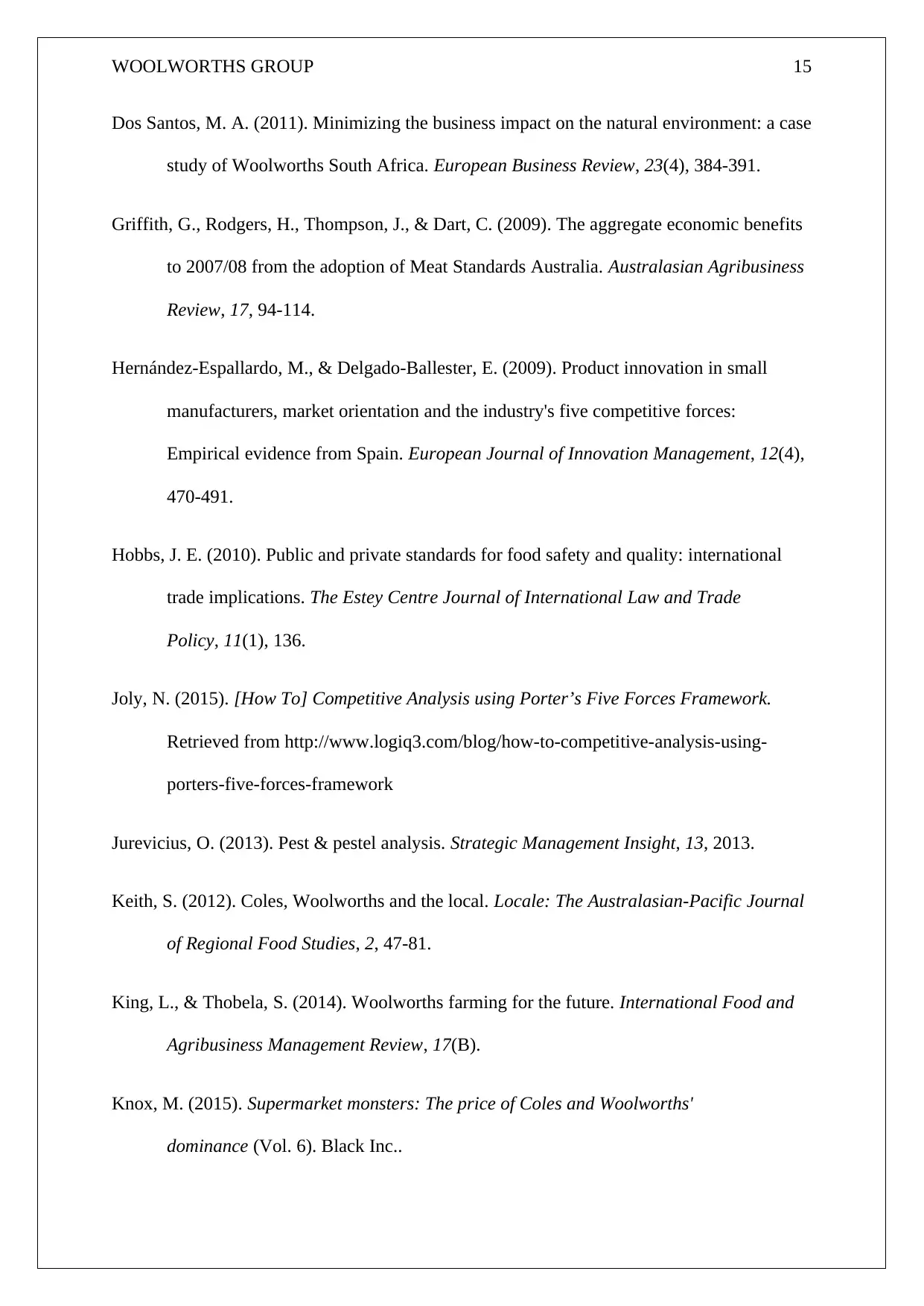
WOOLWORTHS GROUP 15
Dos Santos, M. A. (2011). Minimizing the business impact on the natural environment: a case
study of Woolworths South Africa. European Business Review, 23(4), 384-391.
Griffith, G., Rodgers, H., Thompson, J., & Dart, C. (2009). The aggregate economic benefits
to 2007/08 from the adoption of Meat Standards Australia. Australasian Agribusiness
Review, 17, 94-114.
Hernández-Espallardo, M., & Delgado-Ballester, E. (2009). Product innovation in small
manufacturers, market orientation and the industry's five competitive forces:
Empirical evidence from Spain. European Journal of Innovation Management, 12(4),
470-491.
Hobbs, J. E. (2010). Public and private standards for food safety and quality: international
trade implications. The Estey Centre Journal of International Law and Trade
Policy, 11(1), 136.
Joly, N. (2015). [How To] Competitive Analysis using Porter’s Five Forces Framework.
Retrieved from http://www.logiq3.com/blog/how-to-competitive-analysis-using-
porters-five-forces-framework
Jurevicius, O. (2013). Pest & pestel analysis. Strategic Management Insight, 13, 2013.
Keith, S. (2012). Coles, Woolworths and the local. Locale: The Australasian-Pacific Journal
of Regional Food Studies, 2, 47-81.
King, L., & Thobela, S. (2014). Woolworths farming for the future. International Food and
Agribusiness Management Review, 17(B).
Knox, M. (2015). Supermarket monsters: The price of Coles and Woolworths'
dominance (Vol. 6). Black Inc..
Dos Santos, M. A. (2011). Minimizing the business impact on the natural environment: a case
study of Woolworths South Africa. European Business Review, 23(4), 384-391.
Griffith, G., Rodgers, H., Thompson, J., & Dart, C. (2009). The aggregate economic benefits
to 2007/08 from the adoption of Meat Standards Australia. Australasian Agribusiness
Review, 17, 94-114.
Hernández-Espallardo, M., & Delgado-Ballester, E. (2009). Product innovation in small
manufacturers, market orientation and the industry's five competitive forces:
Empirical evidence from Spain. European Journal of Innovation Management, 12(4),
470-491.
Hobbs, J. E. (2010). Public and private standards for food safety and quality: international
trade implications. The Estey Centre Journal of International Law and Trade
Policy, 11(1), 136.
Joly, N. (2015). [How To] Competitive Analysis using Porter’s Five Forces Framework.
Retrieved from http://www.logiq3.com/blog/how-to-competitive-analysis-using-
porters-five-forces-framework
Jurevicius, O. (2013). Pest & pestel analysis. Strategic Management Insight, 13, 2013.
Keith, S. (2012). Coles, Woolworths and the local. Locale: The Australasian-Pacific Journal
of Regional Food Studies, 2, 47-81.
King, L., & Thobela, S. (2014). Woolworths farming for the future. International Food and
Agribusiness Management Review, 17(B).
Knox, M. (2015). Supermarket monsters: The price of Coles and Woolworths'
dominance (Vol. 6). Black Inc..
Secure Best Marks with AI Grader
Need help grading? Try our AI Grader for instant feedback on your assignments.
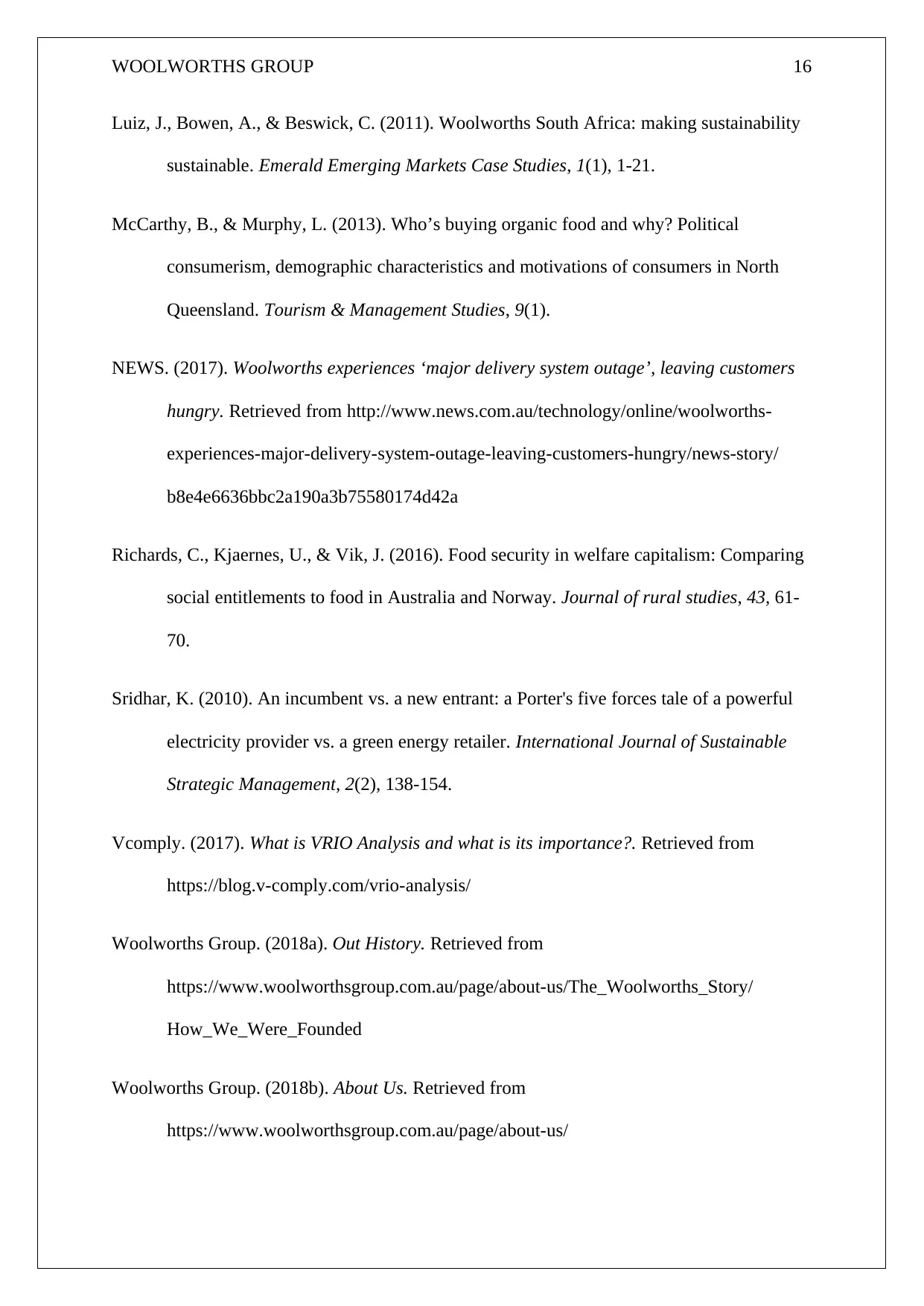
WOOLWORTHS GROUP 16
Luiz, J., Bowen, A., & Beswick, C. (2011). Woolworths South Africa: making sustainability
sustainable. Emerald Emerging Markets Case Studies, 1(1), 1-21.
McCarthy, B., & Murphy, L. (2013). Who’s buying organic food and why? Political
consumerism, demographic characteristics and motivations of consumers in North
Queensland. Tourism & Management Studies, 9(1).
NEWS. (2017). Woolworths experiences ‘major delivery system outage’, leaving customers
hungry. Retrieved from http://www.news.com.au/technology/online/woolworths-
experiences-major-delivery-system-outage-leaving-customers-hungry/news-story/
b8e4e6636bbc2a190a3b75580174d42a
Richards, C., Kjaernes, U., & Vik, J. (2016). Food security in welfare capitalism: Comparing
social entitlements to food in Australia and Norway. Journal of rural studies, 43, 61-
70.
Sridhar, K. (2010). An incumbent vs. a new entrant: a Porter's five forces tale of a powerful
electricity provider vs. a green energy retailer. International Journal of Sustainable
Strategic Management, 2(2), 138-154.
Vcomply. (2017). What is VRIO Analysis and what is its importance?. Retrieved from
https://blog.v-comply.com/vrio-analysis/
Woolworths Group. (2018a). Out History. Retrieved from
https://www.woolworthsgroup.com.au/page/about-us/The_Woolworths_Story/
How_We_Were_Founded
Woolworths Group. (2018b). About Us. Retrieved from
https://www.woolworthsgroup.com.au/page/about-us/
Luiz, J., Bowen, A., & Beswick, C. (2011). Woolworths South Africa: making sustainability
sustainable. Emerald Emerging Markets Case Studies, 1(1), 1-21.
McCarthy, B., & Murphy, L. (2013). Who’s buying organic food and why? Political
consumerism, demographic characteristics and motivations of consumers in North
Queensland. Tourism & Management Studies, 9(1).
NEWS. (2017). Woolworths experiences ‘major delivery system outage’, leaving customers
hungry. Retrieved from http://www.news.com.au/technology/online/woolworths-
experiences-major-delivery-system-outage-leaving-customers-hungry/news-story/
b8e4e6636bbc2a190a3b75580174d42a
Richards, C., Kjaernes, U., & Vik, J. (2016). Food security in welfare capitalism: Comparing
social entitlements to food in Australia and Norway. Journal of rural studies, 43, 61-
70.
Sridhar, K. (2010). An incumbent vs. a new entrant: a Porter's five forces tale of a powerful
electricity provider vs. a green energy retailer. International Journal of Sustainable
Strategic Management, 2(2), 138-154.
Vcomply. (2017). What is VRIO Analysis and what is its importance?. Retrieved from
https://blog.v-comply.com/vrio-analysis/
Woolworths Group. (2018a). Out History. Retrieved from
https://www.woolworthsgroup.com.au/page/about-us/The_Woolworths_Story/
How_We_Were_Founded
Woolworths Group. (2018b). About Us. Retrieved from
https://www.woolworthsgroup.com.au/page/about-us/
1 out of 17
Related Documents
Your All-in-One AI-Powered Toolkit for Academic Success.
+13062052269
info@desklib.com
Available 24*7 on WhatsApp / Email
![[object Object]](/_next/static/media/star-bottom.7253800d.svg)
Unlock your academic potential
© 2024 | Zucol Services PVT LTD | All rights reserved.





